
The Muscle-Building Workout Plan for Skinny Beginners
Most skinny guys are eager to build muscle fast. I don’t blame them. I was the same way. When I weighed 130 pounds, with a BMI under 17, I was sick of being skinny. I wanted to get out of that situation as quickly as possible.
The best way to build muscle is to lift weights. Most of us know that. But I had just graduated from university with a degree in graphic design, I’d never been active, and I didn’t know a single person who lifted weights. Well, I knew one person who shoplifted, but I didn’t want any part of that. And when you’re that far outside of a subculture, it can be hard to know where to start or what to do.
Since then, I’ve gained 70 pounds, going from a 65-pound bench press to a 315-pound bench press. My business partner, Marco, has helped college, professional, and Olympic athletes bulk up. Together, we’ve spent over a decade helping millions of readers and over 10,000 skinny clients build muscle (naturally).
Fortunately, once skinny guys start following a good workout plan and eating a proper bulking diet, we can gain muscle faster than any other body type. Our frames are empty and eager for muscle growth. Most of us are able to gain 25 pounds within our first 6 months of working out. Some of our clients have gained 40.
In this article, I’ll walk you through the process of training for muscle growth. By the end, you’ll know exactly what to do.
The History of Muscle-Building Workouts
The Very First Muscle Size Program for Skinny Guys

Back in the 1920s, Charles Atlas came up with the first muscle-building program for skinny guys. This was back in the good old days, back before the word “ectomorph” was coined, back before skinny guys even knew they could build muscle. Back then, being skinny was just a body type. If you were skinny, you were skinny. That was it.
The problem was, the good old days weren’t so good for skinny guys. Even back in the 1920s, muscular men got more attention from women and more respect from other men. The skinny guys didn’t want to be skinny, but they didn’t realize they could do anything about it. It was considered an immutable trait.
Charles Atlas saw an opportunity there. He designed a workout program that he could market to these skinny guys. He called it the Dynamic Resistance Fitness Course. He placed advertisements in magazines calling out to “98-pound weaklings” who were desperate to bulk up.

It worked, too. All over the world, pre-ectomorph ectomorphs began placing their orders, eager to finally build enough muscle to look good on the beach, eager to stop having sand kicked in their faces.
Atlas’ theory was that you could “pit muscle against muscle” to create the tension needed to stimulate muscle growth. For example, when you flex your biceps, you need to clench both your biceps and your triceps. The two muscles work agonistically, allowing them to flex against each other.
Atlas claimed that this muscle-against-muscle tension would stimulate muscle growth. Then, as your muscles become stronger, the resistance becomes more intense, allowing you to become stronger still. Best of all, you could do this workout program from the privacy of your own home. No equipment required.
The Fall of Charles Atlas
However, Charles Atlas was soon accused of false advertising. Bob Hoffman, the founder of York Barbell, believed lifting weights was the only way to build an impressively muscular physique. He saw that Atlas was impressively muscular and figured he must be a weight lifter. When Atlas claimed that he built his physique with his bodyweight routine, Hoffman accused him of being a liar—a fraud!
Hoffman brought Atlas to court. On the stand, Atlas proclaimed his innocence. He really did do his flexing routine every day. However, when the lawyers asked him if he also lifted weights, he admitted that he did, occasionally, but only to test his strength. Under cross-examination, he admitted that he “tested his strength” 3–4 times per week. Charles Atlas didn’t even trust his own workout routine.
A 2014 study published in the European Journal of Applied Physiology found that flexing does indeed stimulate a little bit of muscle growth. Doing a biceps flexing routine three times per week for 12 weeks produced a 4% increase in both biceps and triceps size. However, those results pale in comparison to the amount of muscle you can build with a proper workout routine.
This is the grey area that most workout programs live in. They work, yes, but not very well. And they work on most people, yeah, but not on everyone. This is how skinny guys wind up trying workout routine after workout routine without ever getting results.
The Face of P90X Was a Bodybuilder
P90X is a bodyweight workout routine supposed to help guys build muscle, but it’s fronted by a bodybuilder who built his physique with weights. When you see Tony Horton leading the P90X workouts, you might assume he got in shape by doing P90X. But you can never make that assumption. Horton built his body by lifting weights. He was a bodybuilder.
I don’t mean to single out P90X. This is standard practice in the fitness industry and is often relatively innocent. You’ll have a guy who builds muscle by lifting weights. Once he’s happy with his muscle size, he loses interest in building more muscle, so he shifts his focus to other forms of physical activity. That’s what happened with Horton. He never lied. People just never bothered to check.
The Colorado Experiment and the Magic of Muscle Memory
Jump forward to the 70s, when Arthur Jones introduced his most famous idea: High-Intensity Training (HIT). The idea behind HIT is that you do a single set for each exercise, moving the weight extremely slowly and going all the way to total muscular failure.

HIT is quite difficult to do with free weights. It’s a totally unathletic way of lifting. It’s hard to move a heavy weight slowly without losing your balance. But that was okay. Arthur Jones made his living selling exercise machines. That was how he monetized his strange new workout routine.
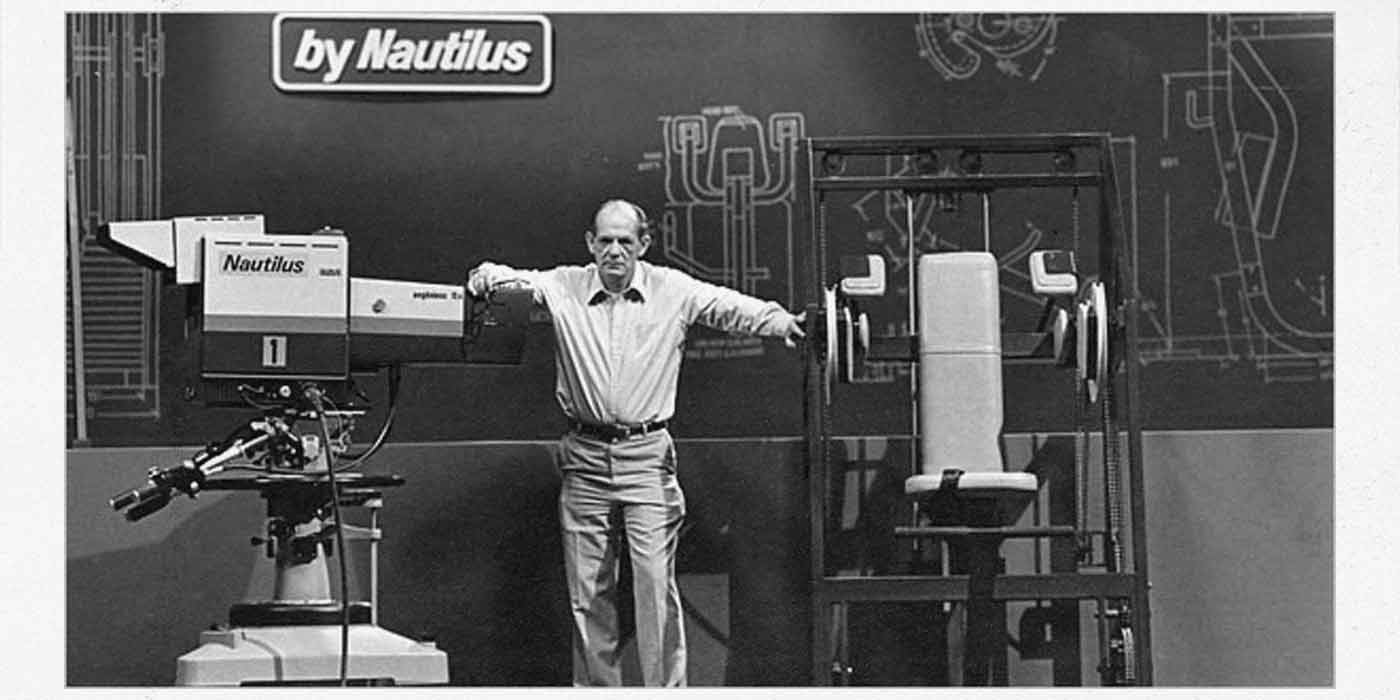
To advertise his exercise machines, Jones enlisted the help of his protégé, a professional bodybuilder, Casey Viator. Over the course of 28 days, Arthur Jones coached Viator through the HIT program. They trained three times per week, with each workout lasting 30 minutes. In a single month, Casey Viator gained an astounding 63 pounds of muscle.
This was unheard of at the time. It’s still unheard of to this day. Was this revolutionary new bulking routine really that powerful? Unfortunately, no. It wasn’t. A recent study looked at how training volume impacts muscle growth. I’ve extrapolated the results for a 150-pound man:
- 1 set of squats per week: 0 pounds muscle, 0 pounds fat, squat strength went up 36 pounds.
- 4 sets of squats per week: 0 pounds muscle, -3 pounds fat, squat strength went up 46 pounds.
- 8 sets of squats per week: 5 pounds muscle, -2.5 pounds fat, squat strength went up 82 pounds.
In this study, doing a single set per exercise wasn’t enough to stimulate a noticeable amount of muscle growth. 4 sets were better, but the participants weren’t eating enough, so they weren’t able to build any muscle. 8 sets were enough to cause simultaneous muscle growth and fat loss.
That leaves us with a mystery. If Casey Viator’s methods were worse, why were his results so extraordinary? There are a few possible explanations:
- Casey Viator had some of the best muscle-building genetics in the world. He’d won the title of Mr. Universe at age 19. He was an extreme outlier.
- Viator was regaining lost muscle mass. Viator injured one of his fingers one year before the experiment. He got a tetanus shot to prevent infection but had a severe allergic reaction to the shot. He lost his ability to eat and exercise for almost a year, losing dozens of pounds of muscle.
- Viator was being paid for every pound of muscle he gained. He wanted the most dramatic transformation possible. So, for two months, he restricted himself to 800 calories per day, losing as much muscle as he could.
- After his HIT workouts, Viator supposedly snuck in extra sets. Viator knew that doing more work would stimulate more muscle growth, so he put in the extra work.
- Viator was presumably using PEDs during the experiment.
Over the past five decades, research has consistently shown that slow lifting isn’t a good way to build muscle (study, study, study). Neither is low-volume training (systematic review). Taking sets to total muscle failure doesn’t help either (study, study).
Tim Ferriss & Occam’s Protocol
In his Geek to Freak experiment, the best-selling author Tim Ferriss followed a HIT workout plan, using it to rebuild 34 pounds of muscle mass in 28 days. Like Viator, Ferriss was detrained and underfed in the year leading up to his transformation, which allowed him to regain muscle incredibly fast. Ferriss was fully open about that.
When Tim Ferriss published his fitness book, The 4-Hour Body, his workout routine became popular with skinny guys trying to build muscle. They saw that Tim Ferris was skinny in the before photo and muscular in the after photo, not realizing the role muscle memory played in his transformation.
Eventually, it became clear that most skinny guys couldn’t reproduce Tim Ferriss’ dramatic results, so the routine faded from popularity.
The Liver King Scandal
Perhaps the most nefarious deceivers of all are the guys who falsely claim to be natural. The so-called “fake natties.” These guys build impossible physiques by abusing PEDs, then sell supplements that ostensibly produce those impossible results.
The most famous example is the Liver King, who made millions by selling “ancestral supplements” and teaching a primal lifestyle. It eventually came out that he was using tens of thousands of dollars of PEDs every month. He was forced to admit the lie, and his supplements immediately lost their lustre.
Unconventional Methods are Less Likely to Work
Plenty of bizarre muscle-building workouts are marketed to skinny guys. In my teens and early twenties, I tried my fair share of them. I thought that maybe, just maybe, a radical new workout program could produce radical new muscle growth.
We’re quick to toss out conventional wisdom because we want to get better-than-conventional results. But the very things that make unconventional workouts appealing are what make them unlikely to work.

We forget that conventional methods are able to consistently produce great results. We averaged out the results of guys bulking with our Bony to Beastly Program. On average, they gained 26 pounds and added 2 inches to their arms within 6 months.
There’s no magic method. It’s just a proper combination of good hypertrophy training, a nutritious bulking diet, eating enough food, and living a healthy lifestyle that supports muscle growth. We also offer feedback on every progress update, answer questions, and help them deal with issues. That’s how we’re able to guarantee results.
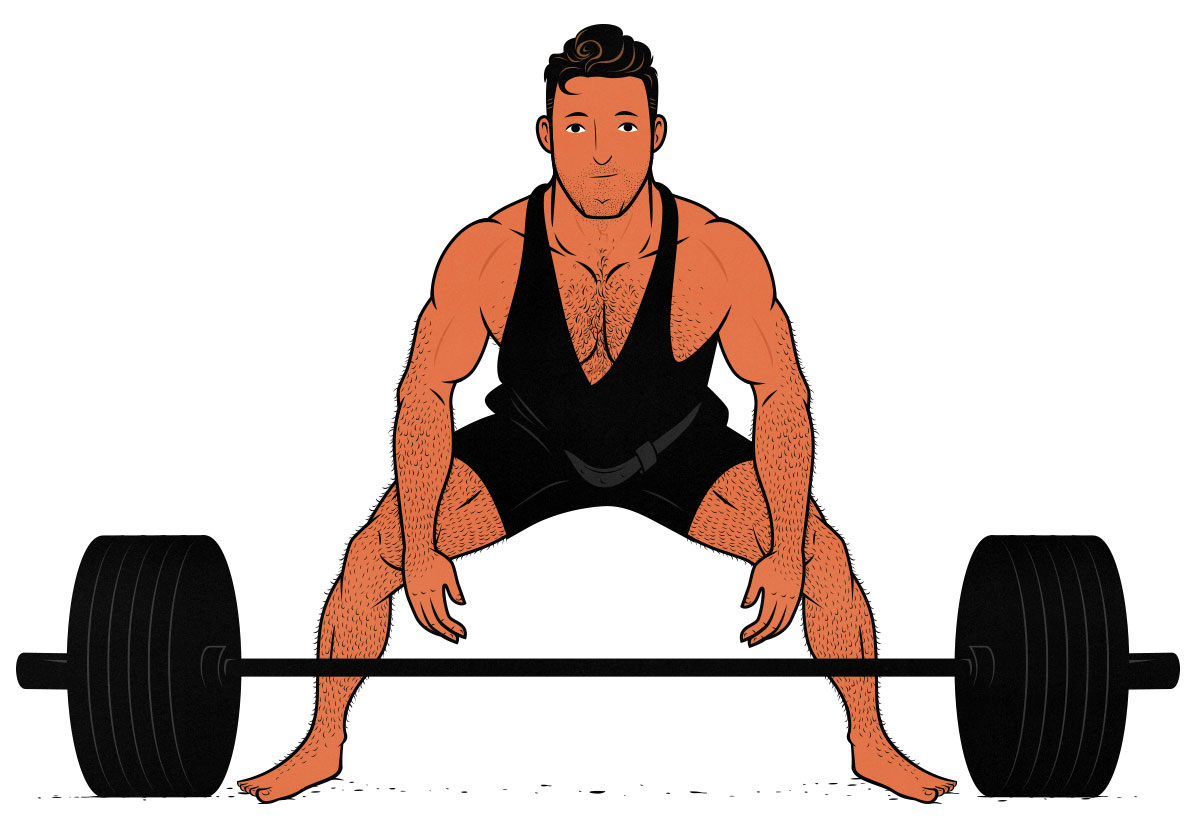
The Best Workouts for Building Muscle
General Fitness Workouts
General fitness workouts are great, but they aren’t great for building muscle. Insofar as you challenge your muscles, you can stimulate a bit of muscle growth, but these workouts are mainly designed to challenge your aerobic system. Your heart will grow fitter, you’ll build more blood vessels, and your body will use oxygen more efficiently, giving you greater endurance.
These adaptations are fantastic. Cardio is an important part of a good fitness routine. But it isn’t the best way to stimulate muscle growth. Not even close.
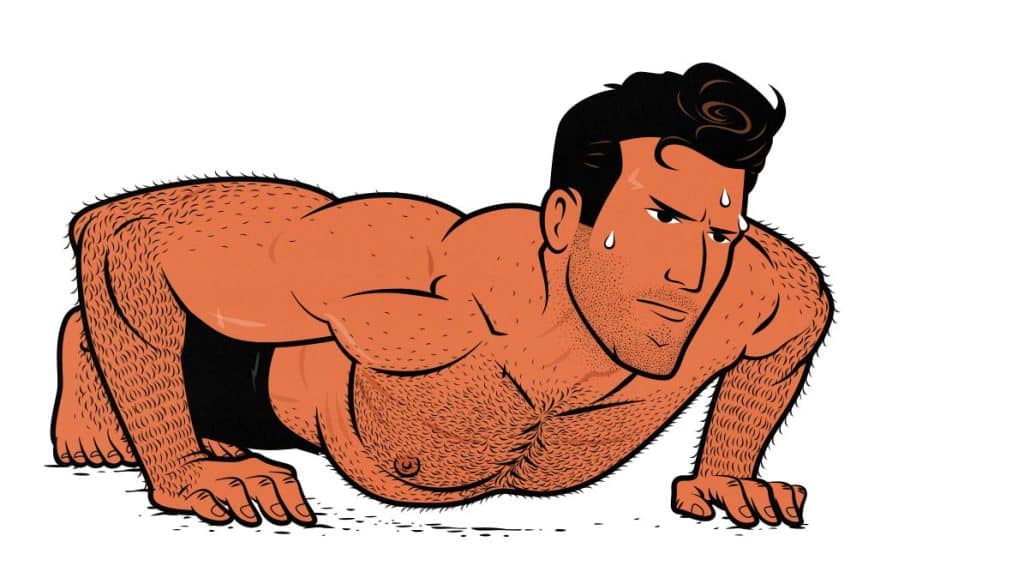
Strength Training Workouts
At the other end of the spectrum, we have strength training. This one is tricky. Some people use “strength training” to refer to any type of resistance training. In that sense, every workout routine is strength training. That isn’t wrong, but it’s confusing, and it’s not how lifters talk.
Among lifters, strength training is the type of training designed to increase how much you can lift for one all-out repetition. It’s designed to increase your 1-rep max. Think of sports like powerlifting, where you’re judged by how much you can squat, bench, and deadlift for a single repetition. The stronger you are in your weight class, the better your score is.
Strength training absolutely stimulates muscle growth, but the main purpose is to make you stronger for your size. The main adaptation is neurological. Your muscles prefer to pace themselves, rationing out their effort over several repetitions. Strength training helps you override that instinct, contracting all your muscle fibres at once.
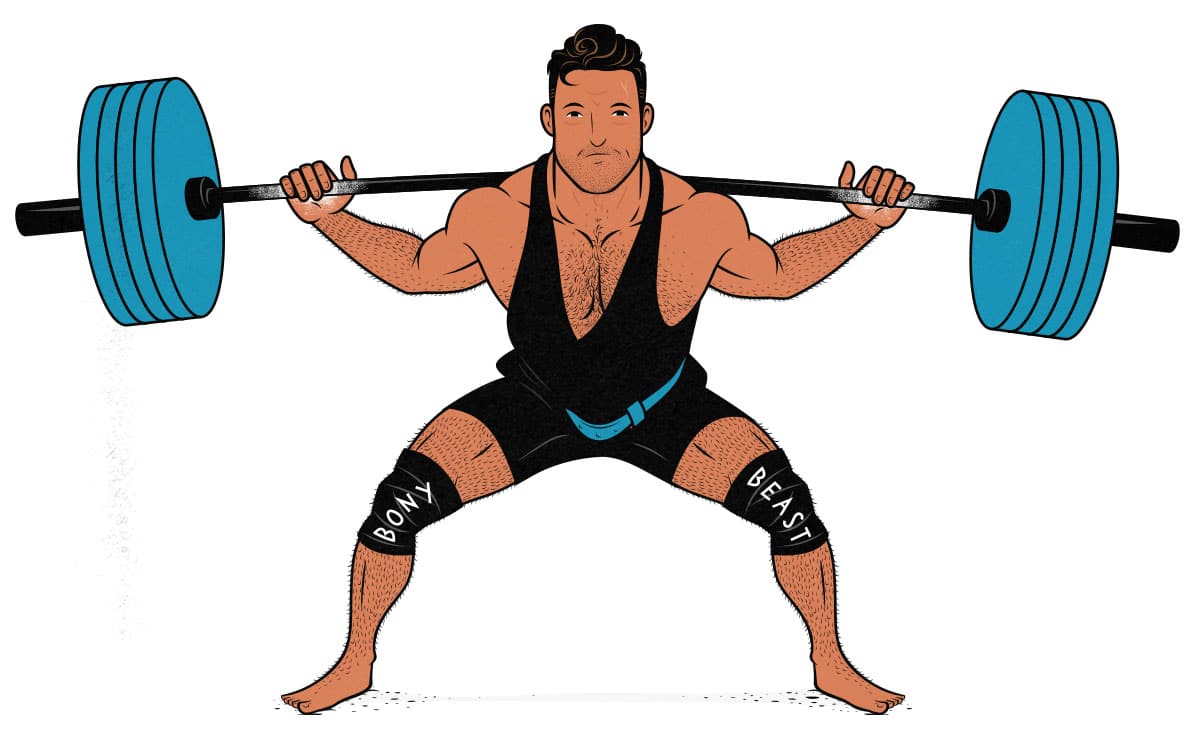
But maximal strength is only one component of strength. There’s also strength endurance: how many reps you can do with a given weight. You can go from benching 65 pounds for 5 reps to benching 225 pounds for 15 reps. That kind of adaptation is arguably even more important than increasing your 1-rep max.
Bodybuilding Workouts
Bodybuilding is another word with a few different definitions. Some people use “bodybuilding” to refer to any type of training that stimulates muscle growth. By that definition, bodybuilding lines up perfectly with our goal.
Among lifters, bodybuilding usually means training for aesthetics. That can mean training for muscle growth, getting spray tans, learning posing routines, and cutting down to very low body fat percentages (more on how to cut here).
You might hear that bodybuilders are big but weak. That isn’t quite true. Bodybuilding is fantastic for improving your strength endurance. You’ll grow bigger and stronger, just without any special emphasis on increasing your 1-rep max on the squat, bench press, and deadlift. You can also do different variations of those lifts, like Romanian deadlifts or step-ups instead of conventional barbell deadlifts. That makes bodybuilding an impressively versatile, safe, and healthy way to work out.
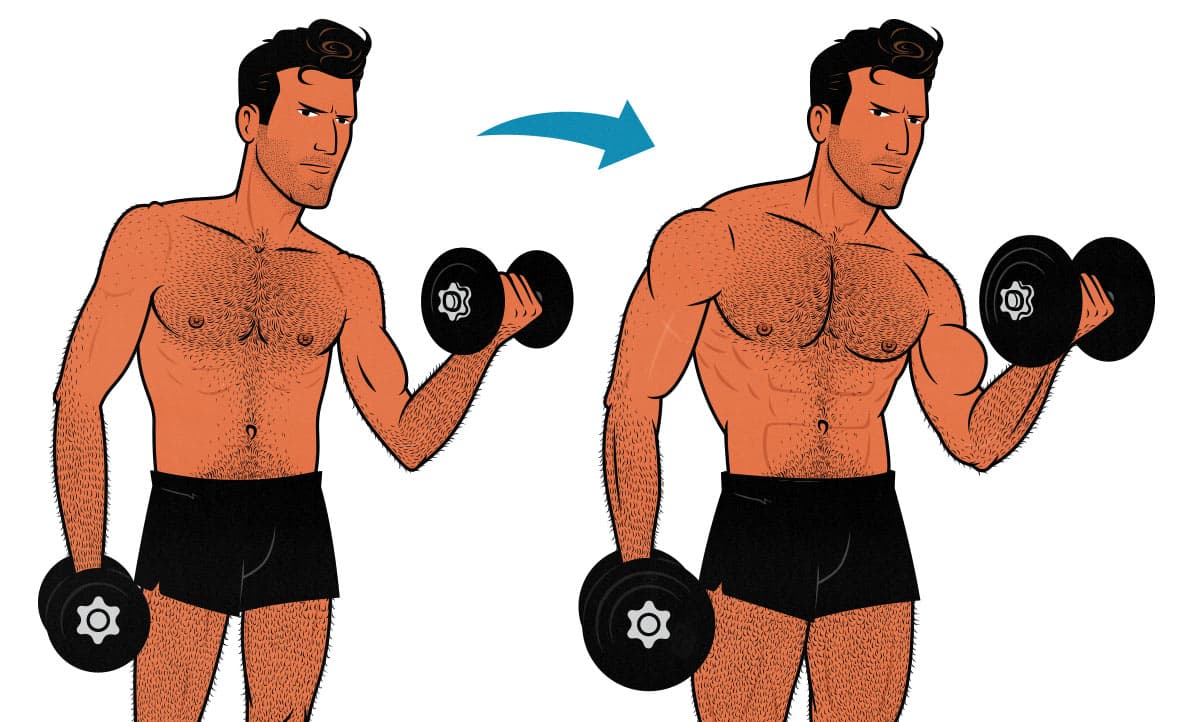
The unhealthy side of natural bodybuilding comes from the obsession with extreme leanness. But that isn’t really our concern. Most casual lifters aren’t interested in torturing themselves to get down to 6% body fat. And besides, that has nothing to do with bodybuilding workout routines.
Still, bodybuilding isn’t quite synonymous with training for muscle growth. It’s possible to bulk up without focusing solely on aesthetics. We can get even more specific.
PowerBuilding Workouts
PowerBuilding is a combination of powerlifting and bodybuilding. This style of training drew me in. I wanted to be big, strong, and look good. That desire still lingers. I’ve worked up to a 315-pound bench press. I’m working on a 500-pound deadlift. I want to hit those strength benchmarks. I love getting stronger at the big compound lifts.
Still, there’s a better way to train for muscle growth. There’s no need to train like a powerlifter while bulking up. It adds extra effort without adding extra muscle size. There’s also no need to practice bodybuilding poses or anything that goes along with bodybuilding.
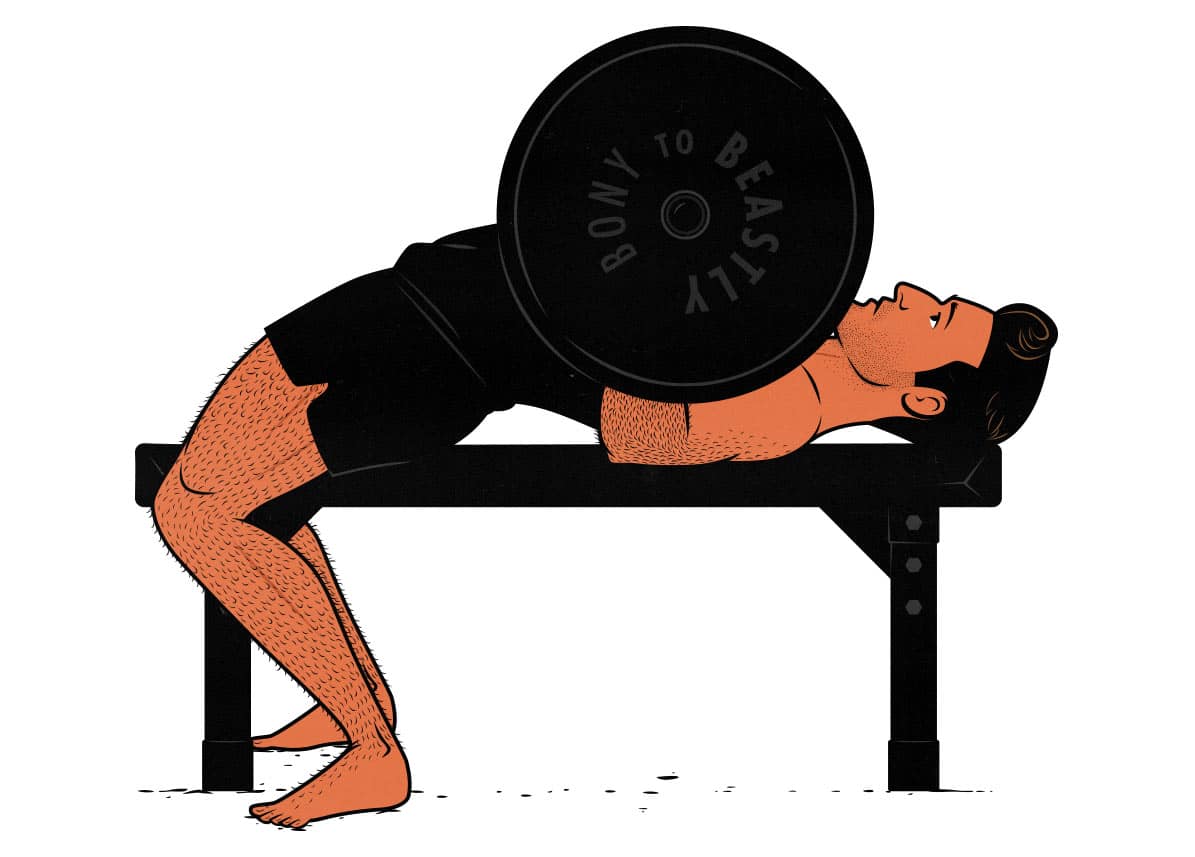
Hypertrophy Training
Hypertrophy training means training for muscle growth. Bodybuilders do hypertrophy training when they’re bulking up. Powerlifters do hypertrophy training when they’re trying to get bigger and stronger. Marco’s specialty was helping top athletes use hypertrophy training to improve their athletic performance.
Here are the hypertrophy training principles that will help you build more muscle:
- Challenge your muscles. Your muscles grow when you bring them to the brink of failure. Get within 1–2 reps of failure. The only way to learn how to stop just shy of failure is to fail sometimes. Don’t be afraid to push yourself, especially on isolation exercises.
- Train every muscle 3x per week. A rigorous workout stimulates 2–3 days of muscle growth, so you can keep your muscles growing steadily all week long by training them every second or third day. The simplest way to do that is with 3 full-body workouts per week (research breakdown).
- Always try to outlift yourself. Every workout, try to lift more than the last workout, whether that’s lifting more weight, doing more reps, or lifting with better technique. Fighting for improvement drives muscle growth (more on progressive overload here).
- Focus on the big compound exercises. Think of goblet squats, push-ups, Romanian deadlifts, and chin-ups. Those four movements train all the major muscle groups in your body. You can build a tremendous amount of muscle with them.
- Fill in the gaps with isolation lifts. Some muscles aren’t trained properly by compound exercises. Some of those muscles are tremendously important. For example, your biceps can’t engage properly during pulling movement. You need biceps curls. Similarly, your triceps need triceps extensions, and your shoulders need lateral raises.
- Do 6–20 reps per set most of the time. You can occasionally drop to 4 reps per set or climb as high as 40. But spend most of your time lifting in a moderate rep range. Doing 6–20 reps stimulates the most muscle growth per set (research breakdown).
- Do 2–4 sets per exercise. If you’re following the rest of these principles, that should be just enough to maximize your rate of muscle growth (research breakdown).
Let’s go through these principles one by one. Then, we can assemble them into a workout routine.
How to Train for Muscle Size
Rest, Recover & Outlift Yourself
A rigorous workout stresses your muscles, provoking an adaption. Then you’ll need to wait (and eat!) as your muscles recover and grow. During that period, you’ll feel sore, and your muscles will be weaker. But within 2–3 days, they’ll grow back bigger and stronger than before.
That cycle of rest, recovery, and growth gives our workout plan a cadence:
- Monday: Lift
- Tuesday: Rest
- Wednesday: Lift more
- Thursday: Rest
- Friday: Lift even more
- Saturday: Rest
- Sunday: Rest
One way to progressively overload your exercises is to add weight. That’s why weights were invented. One workout, you curl 20-pound dumbbells. Next workout, you curl 25-pound dumbbells.
You can also add extra repetitions. If you get 11, 10, and 9 repetitions (30 reps) in one workout, try to get 31 or more repetitions next time. That, too, will encourage your muscles to continue growing.
Barbells, dumbbells, and exercise machines are all great for this. Some bodyweight exercises are great, too. Whatever you’re using, the important thing is to always strive to outlive yourself.
Keep Your Muscles Growing All Week Long
A rigorous workout stimulates 2–4 days of muscle growth in the muscles you train. When your muscles recover, you can stimulate a new wave of muscle growth (study). This is why doing a 3-day full-body split tends to be the quickest and most reliable way to build muscle, especially for beginners.
- Monday: Full-body workout
- Tuesday: Rest
- Wednesday: Full-body workout
- Thursday: Rest
- Friday: Full-body workout
- Saturday: Rest
- Sunday: Rest
There are other ways to organize your workouts. You could do a workout split, where you split your body up into different body parts, training a portion of your body every day. Beginners tend to benefit from full rest days, though. Better to use full-body workouts for now.
If you’re skinny and desperate to build muscle, I know it can be tempting to do more. The best way to build muscle, though, is to put your full effort into your workouts, take a full day of rest, and then do it again, focusing on outlifting yourself.
Beginners can build muscle incredibly fast. 3 full-body workouts per week are enough to maximize your rate of muscle growth. Invest the rest of your effort into eating a good bulking diet, getting to bed on time, and living a healthy lifestyle. That’s how you’ll get the best bulking results.
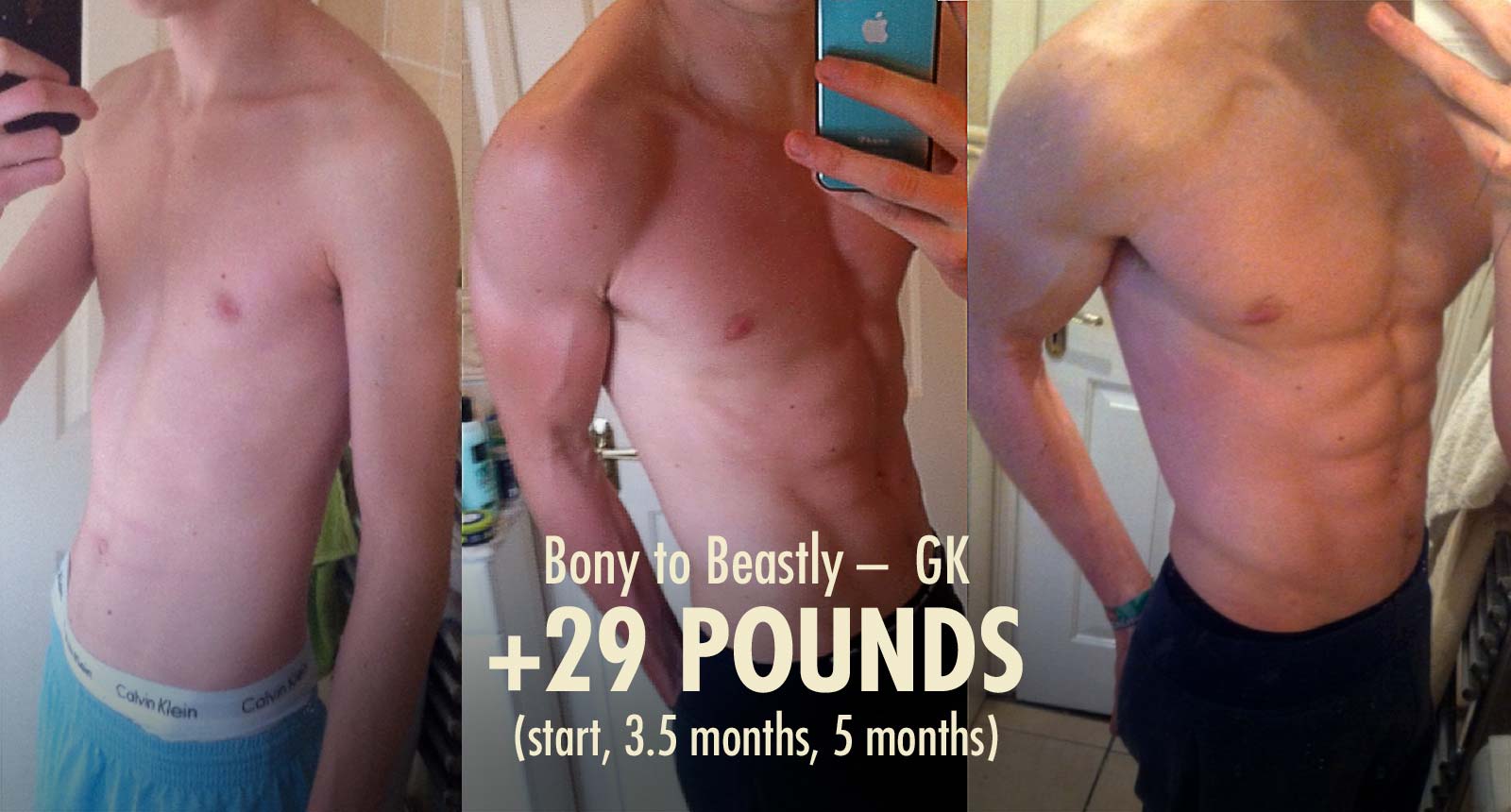
The 4 Big Compound Lifts
Most strength training programs focus on the Big 3: the squat, bench press, and deadlift. There’s wisdom in that. These exercises do an incredible job of stimulating muscle growth and measuring strength. We can do even better.
If you’re already good at lifting weights, we have an article on the best compound lifts. But if you’re still a beginner, it helps to start at the beginning. Start with simpler exercises that encourage better form. You’ll build muscle faster and more easily. It’s also safer and will do a better job of teaching you the proper lifting form.
Here are the best exercises for gaining your first 20–30 pounds:
- Goblet squats: where you squat while holding a dumbbell in front of you. These work your quads, glutes, core, and upper body. Holding a dumbbell in front of you shifts your centre of gravity forward, keeping your torso more upright and allowing you to squat much deeper. These are amazing for building muscle until you can do sets of 12+ reps with the heaviest dumbbell.
- Romanian Deadlifts: where you start in a standing position, keep your knees stiff, and focus on bending at the hips, lowering the weight until you feel a deep stretch on your hamstrings. These work your hips, hamstrings, and all the muscles in your back.
- Push-ups (or the bench press): where you push your body away from the ground while keeping your torso rigid. Push-ups are famous for training your chest, shoulders, and triceps, but they also train your abs and serratus muscles (under your armpits). Until you grow too strong for them, they’re even more powerful than the bench press.
- Chin-ups (or lat pulldowns or rows): where you pull with your back and biceps. They also do a great job of bulking up your abs and strengthening your grip. If you aren’t strong enough yet, start with lowered chin-ups, lat pulldowns, rows, and/or dumbbell pullovers.

I’d already gained 40 pounds by the time I tested the first version of our Bony to Beastly Bulking Program. Going back to these beginner variations provoked a new wave of muscle growth, helping me gain another 15 pounds.
These variations are simple, but that’s good. The better your coordination is while you lift, the easier it will be to stimulate muscle growth. The challenge will come from the weight you’re lifting.
As you get stronger, you’ll need to find ways to load your lifts heavier. That’s when 100-pound goblet squats turn into 150-pound barbell front squats. That’s the approach we take in our program. Every few weeks, we progress some of the lifts. By the end, you’ll be proficient at all the big exercises.
The Power of Isolation Exercises
Not every muscle responds well to compound exercises. Our bodies are built to do more than just 4 movements. For example, your biceps don’t just flex your arms, they also pull your arms forwards at the shoulder joint, interfering with pulling movements, and preventing them from fully engaging.

That’s where biceps curls come in. The long and short head balance one another out at the shoulder joint, helping to keep it stable while you flex your arms. This allows you to fully engage both heads of your biceps, stimulating twice as much biceps growth.
There are other muscles, like your side delts, that aren’t trained very well by most compound exercises. Overhead presses can work, but not as well as simpler exercises like lateral raises.
You may also want to work some muscles a little harder. Push-ups do a great job of working your entire chest, but if you’re especially eager for your chest to grow, it can help to add in some dumbbell chest flies.
If you’re eager to bulk up a certain area of your body, make sure you have exercises that train those muscles properly. If you want bigger arms, you should include biceps curls and triceps extensions. If you want broader shoulders, you should include lateral raises.
Here are a few isolation exercises you probably want to include in your workout routine:
- Lateral raises to build broader shoulders.
- Biceps curls and triceps extensions to build bigger arms.
- Chest flyes to bulk up the chest.
- Planks to bulk up your abs.
- Neck curls to bulk up your neck.
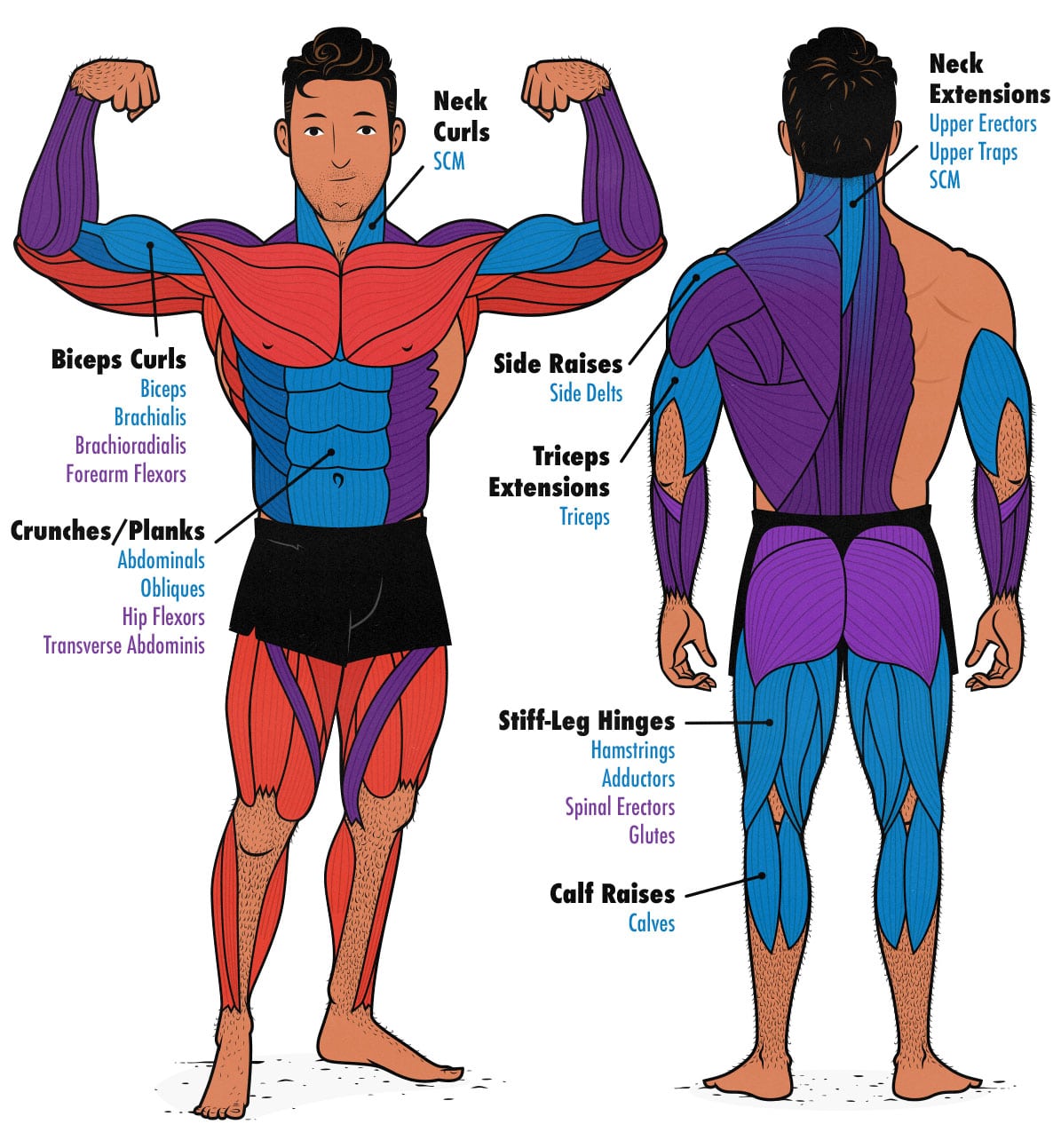
The Workout Plan
This is a simple workout program designed to maximize muscle growth overall, with a bit of extra emphasis on the areas you’re probably most eager to grow. There are simpler workout plans than this one, but they aren’t as effective. There are more complicated workout routines, but they aren’t any more effective.
I’ll link every exercise to one of Marco’s tutorial videos. Marco’s videos are simple on purpose. The best way to learn how to lift weights is to watch a demonstration, get a couple of cues, and then practice. Too much talk of bar path, joint angles, and mind-muscle connection can destroy a beginner’s natural athleticism.
It’s like learning how to walk. If you got a lesson on ankle and knee angles to optimize your walking gait, you’d become conscious of unconscious movements, and your gait would worsen. That approach to teaching exercises can work as an intermediate lifter, but beginners benefit more from simple exercises, simple cues, imitation, and practice.
Workout 1
| Exercise | Sets | Reps |
|---|---|---|
| Romanian Deadlifts | 3 sets | 9 reps |
| Push-ups | 3 sets | AMRAP |
| Dumbbell Bench Press | 3 sets | 11 reps |
| Dumbbell Rows | 3 sets | 11 reps |
| Biceps Curls | 2 sets | 11 reps |
| Triceps Extensions | 2 sets | 11 reps |
| Lateral Raises | 2 sets | 11 reps |
You can go through the entire workout routine exercise by exercise, but if you can, I recommend doing them as supersets. For example, you could do a set of Romanian deadlifts, rest a minute, drop down for a set of push-ups, rest a minute, and then do your second set of Romanian deadlifts. That way, while your hips and back are resting, you’re training your pushing muscles, and vice versa.
Supersets stimulate just as much muscle growth as regular sets, they’re better for improving your fitness, and they cut the length of your workouts in half.
Workout 2
| Exercise | Sets | Reps |
|---|---|---|
| Goblet Squats | 3 sets | 9 reps |
| Underhand Lat Pulldowns | 3 sets | 9 reps |
| Romanian Deadlifts | 3 sets | 9 reps |
| Push-ups | 3 sets | AMRAP |
| Front Planks | 2 sets | 5-10 slow breaths |
| Side Planks | 2 sets | 5-10 slow breaths |
| Farmer Carries | 2 sets | 40 steps |
This workout is similar to the first, but it brings in goblet squats and uses different isolation exercises. By alternating between two different workouts, you’ll build a more balanced physique, gain more versatile strength, and keep your tendons and joints feeling fresher.
Download the Workout Spreadsheets
Most serious lifters prefer spreadsheets over lifting apps because of how customizable they are. For example, we’ve designed these sheets so you can choose your exercises from dropdown menus. You can also move anything around however you like. Plus, you get free access forever.
We’ve built this workout routine into Google Spreadsheets. You can use them on your phone for free with the Google Sheets app. They allow you to record how much weight you lift and how many reps you get.
get the google spreadsheet of the
free beginner’s full-body workout
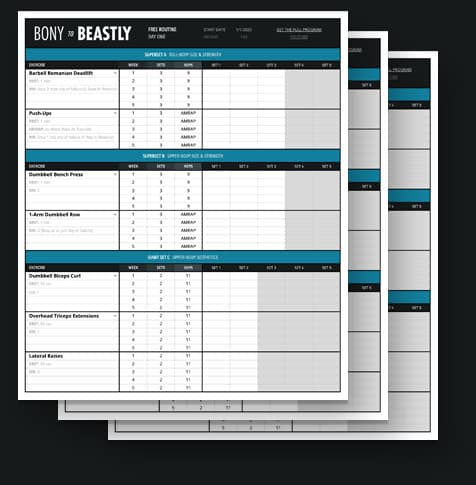
Get the workout as a Google spreadsheet. You’ll be able to pick from exercise alternatives, fill out the sheet, and get our beginner’s warm-up.
Plus, we’ll make sure you’re on the b2B newsletter, and send you all of our best muscle-building content.
Follow the plan closely. Take it seriously. Results come from consistent effort. Every workout, your goal should be to outlift yourself, lifting more weight or eking out more reps than last time.
If a couple of weeks go by where you don’t make progress, you’ll need to find the source of the problem. Small improvements add up to impressive transformations. But if you’ve hit a wall, continuing to walk into it won’t get you anywhere.*
*If you grew up playing RPG games, this may come as a surprise. I had great fun taping down my keys so that my character would run into the corner for hours, levelling up their endurance. Unfortunately, that method doesn’t work in real life.
The End
I know this has been a long article. I know this can be overwhelming at first. Start with the first step and go from there. Do your first workout, even if it isn’t perfect. Once you’ve started, it’s easy to improve. As long as you challenge your muscles, you’ll stimulate muscle growth. Mastery will come with practice.
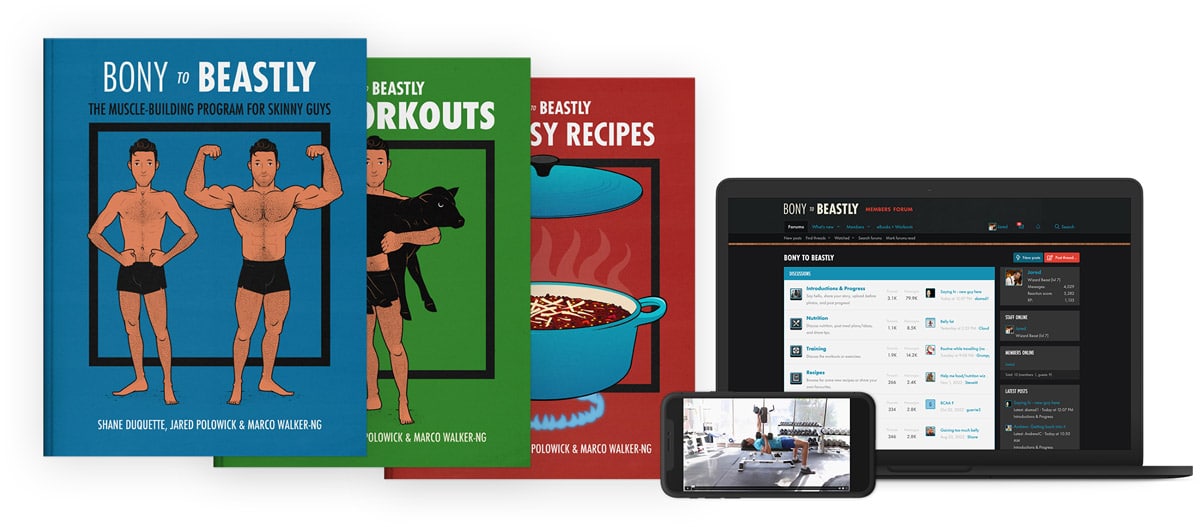
Alright, that’s it for now. If you want more muscle-building information, we have a muscle-building newsletter. If you want us to walk you through the entire process of building muscle, check out our Bony to Beastly Program. It includes a 5-month workout routine, diet guide, recipe book, tutorial videos for every exercise, and one-on-one support from us in our online community.

